Stargazing in New York State (and New York City) offers an exciting blend of urban lights and celestial wonders. You might think the city’s glow dims the stars, but I’ll show you that’s not true.
However, the challenge is real. Light pollution from the city’s bright lights often overshadows the stars, making stargazing seem daunting. Many don’t know where to start or what equipment to use, leading to missed opportunities to enjoy the night sky.
In this article, I’ll guide you through overcoming these hurdles. You’ll learn about the best spots away from city lights, how to choose the right gear, and the optimal times to gaze up. Prepare to unlock the secrets of the New York night sky!
Key Things to Know:
- In New York, prime stargazing spots are in areas with minimal light pollution, like Allegany State Park.
- Winter offers clearer skies for better celestial views.
- Essential gear includes a user-friendly telescope or binoculars and a red-light flashlight.
- Join local astronomy groups for guided stargazing events.
Introduction to New York Stargazing
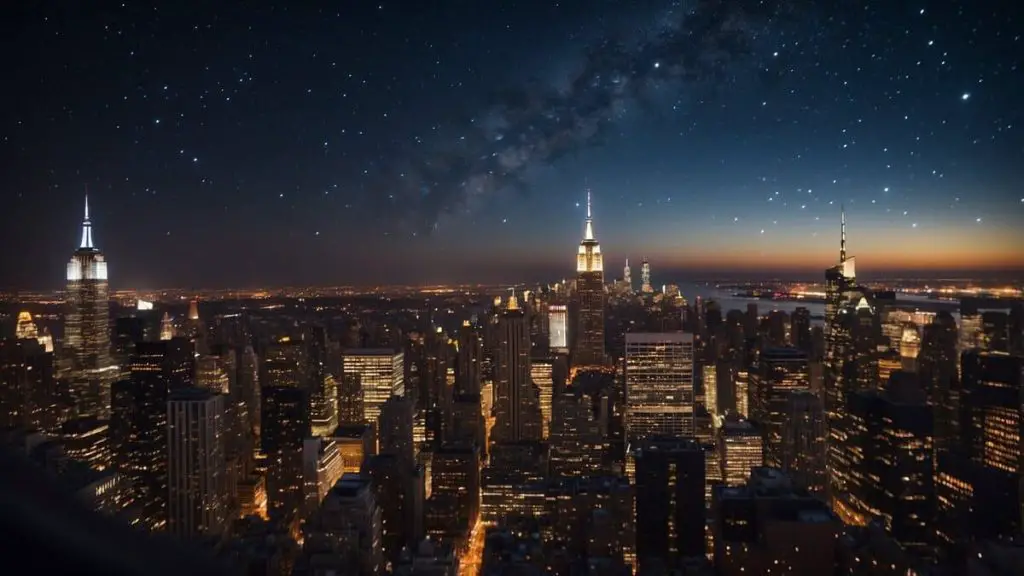
Stargazing in New York offers a unique experience combining urban lights with natural celestial wonders. Here’s what you need to know to start your journey among the stars.
Basics of Stargazing
Understanding the basics of stargazing is your first step.
You need:
- A clear night sky
- A little patience
- Knowledge of where to look
Here are three easy tips to get started:
- Find a dark spot away from city lights.
- Let your eyes adjust to the darkness for about 15 minutes.
- Look up and enjoy the view!
Effects of Light Pollution on Stargazing
Light pollution makes it harder to see the stars. Big city lights brighten the sky and hide many stars from view.
This means you need to:
- Choose spots where city lights are dim.
- Use a stargazing app to help you see what’s usually hidden.
Optimal Seasons for Stargazing
Winter is one of the best times for stargazing in New York. The skies are clearer, and the air is crisp.
Here’s why winter is excellent for stargazing:
- Skies are often clearer: Less haze than in summer.
- Stars can be brighter: The cold air can make them twinkle more.
Remember, dress warmly, and happy stargazing!
Stargazing Equipment
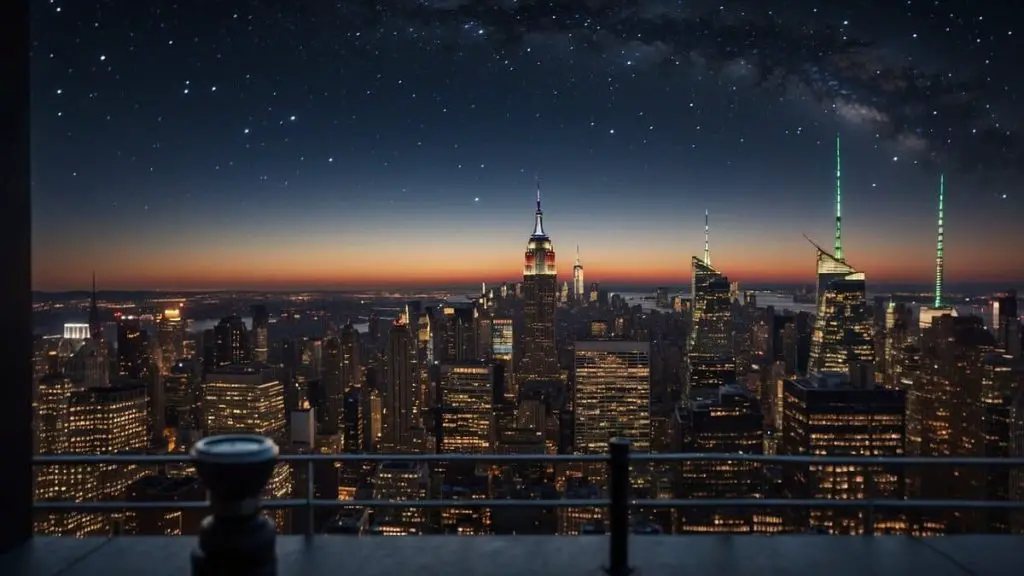
Before you set out for a stargazing night, ensure you have the right gear. The right equipment can make your experience much more enjoyable, but it’s not required.
Choosing the Right Telescope
Picking a telescope is critical to seeing the stars up close.
Here are some tips:
- Go for easy-to-use mounts. A simple tripod can be a great start.
- Choose telescopes with wider apertures. This lets you see more details.
Remember, a good telescope doesn’t have to be pricey. If you’re new, consider starting with a beginner-friendly telescope that allows for growth.
Binoculars for Stargazing
Binoculars can be a great alternative:
- They are portable and user-friendly.
- Go for ones that say “wide angle” for the best views.
You’ll enjoy the stars with a pair of binos without much setup or expense.
Accessories and Navigational Tools
A few extras can help you find and enjoy the stars:
- Star maps help you know what you’re looking at.
- Flashlights with red light keep your night vision sharp.
- Don’t forget a comfortable chair to relax while you watch the sky.
Each tool will help you make the most of your stargazing time.
Best Stargazing Spots in New York State (and NYC)
This section will detail all 30 stargazing locations in this article, right below this list.
The 30 best stargazing spots in New York (from my best stargazing in the US series)
- Allegany State Park
- Beaver Meadow Nature Center / Buffalo Audubon Society
- Beebe Hill State Forest
- Brooklyn Bridge Park
- Catskill Visitor Center
- Custer Institute and Observatory
- Dudley Observatory
- Eighteen Mile Creek County Park
- Fire Island National Seashore
- Gateway National Recreation Area
- Gobbler’s Knob State Forest
- Golden Hill State Park
- Hamptons Observatory
- Harriman State Park
- Hayden Planetarium
- Hemlock Ridge Multiple Use Area
- Hudson River Museum’s Planetarium
- Kensico Dam Plaza
- Kopernik Observatory & Science Center
- Lafayetteville Multiple Use Area
- Letchworth State Park
- Martz-Kohl Observatory
- Montauk Point State Park
- Rochester Museum & Science Center RMSC Strasenburgh Planetarium
- The Adirondack Sky Center & Observatory
- The High Line
- Vanderbilt Museum and Planetarium
- Walkway Over the Hudson
- Wassaic Multiple Use Area
- Wellesley Island State Park
Here is your Free Google Map of the best stargazing in New York to help you plan your journey:
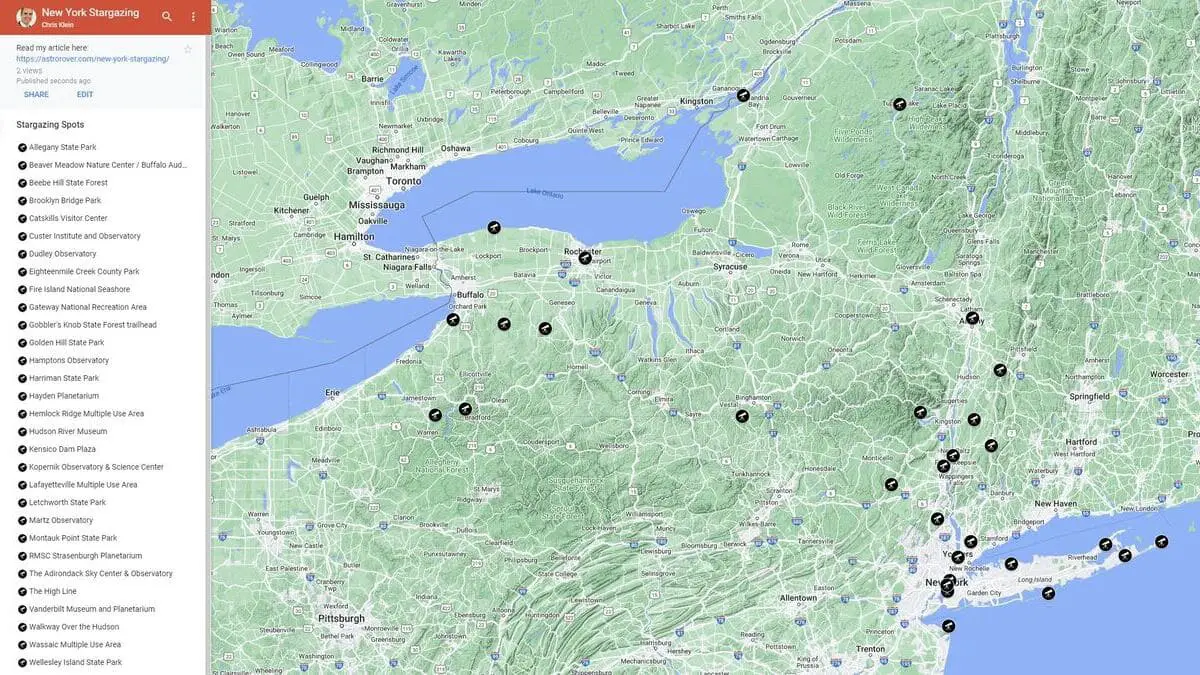
Allegany State Park
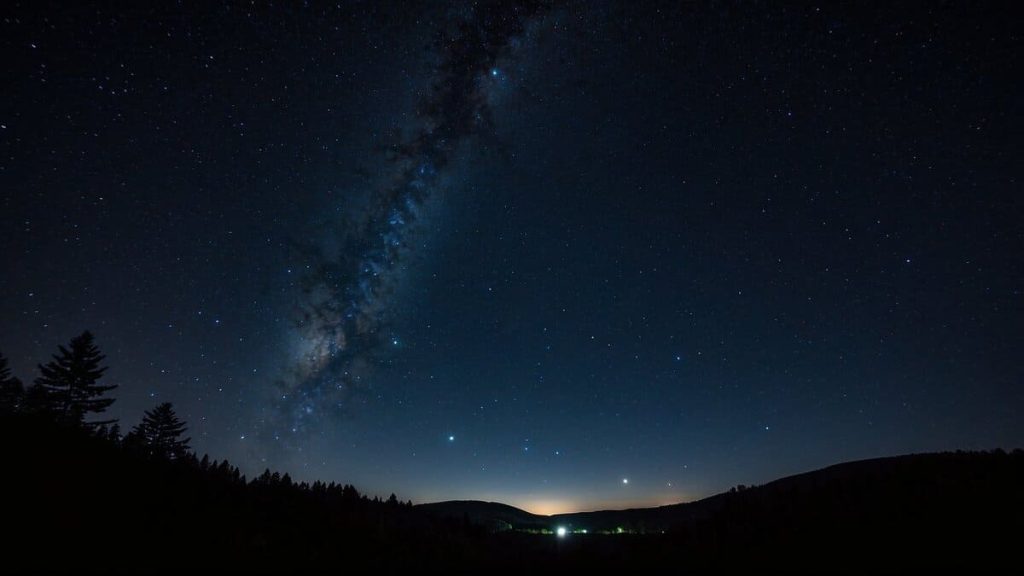
In Allegany State Park, you’ll find a vast stargazing haven in Western New York. This park, one of New York’s largest at over 65,000 acres, is a perfect spot to escape city lights and gaze at the stars. Imagine a day filled with hiking or kayaking, and as night falls, you’re under a sky full of stars. You’re guaranteed a stunning view of the cosmos thanks to minimal light pollution.
Quaker Lake and other park streams offer excellent opportunities if fishing is your passion. After a day by the water, the peacefulness of night adds a new dimension to your experience.
For a relaxed day, paddle boating on Red House Lake is an enjoyable option, letting you soak in the scenery before the stars come out. Plus, if you’re into mountain biking, there are more than 35 miles of trails to explore.
Key Highlights:
- Vast wilderness ideal for stargazing.
- Minimal light pollution for spectacular night skies.
- Various daytime activities include hiking, kayaking, fishing, paddle boating, and mountain biking.
At Allegany State Park, you’re in for an unforgettable stargazing adventure and a day packed with outdoor fun. It’s the perfect place for both nature enthusiasts and amateur astronomers.
For more information, visit the New York Department of Environmental Conservation’s information on Allegany State Park.
FREE STARGAZING CHECKLIST
My 5-page Stargazing Checklist will enhance your astronomical observations.
Follow this free checklist to navigate the night sky with confidence, clarity, and a sense of preparedness for a rewarding stargazing experience.

Beaver Meadow Nature Center / Buffalo Audubon Society
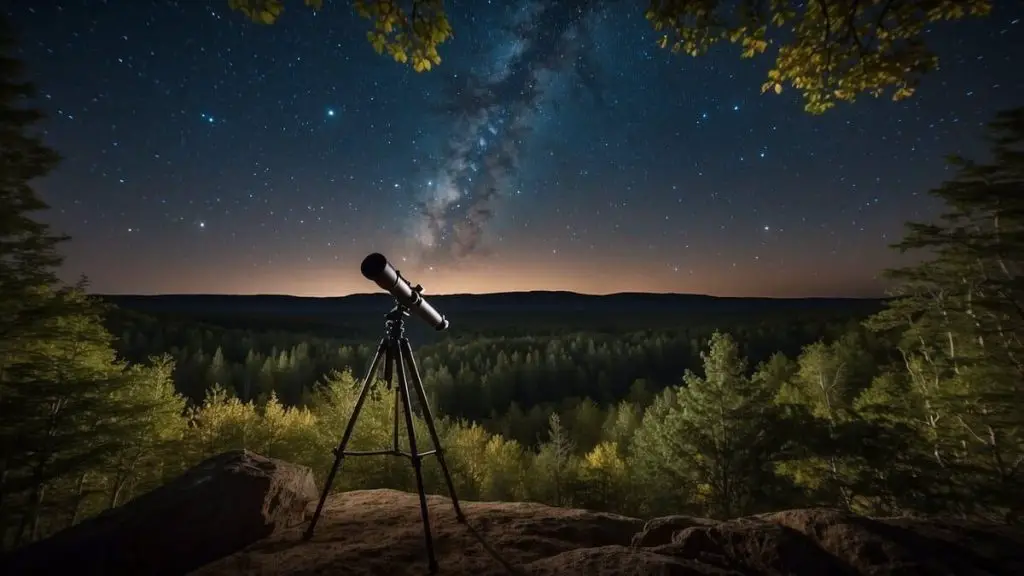
Just 30 minutes from Buffalo in North Java, NY, lies the Beaver Meadow Audubon Center, a 324-acre nature preserve and a stargazing gem. Its dark skies make it an excellent location for observing stars and planets. I was struck by the beauty of its ponds, wetlands, meadows, and wooded uplands during my visit.
The Beaver Meadow Observatory is a key feature here. Managed by the Buffalo Astronomical Association, the observatory houses some of Western New York’s largest telescopes, including a 20-inch Obsession telescope. Open from April to October on select dates, it’s a perfect spot to view planets, star clusters, and distant galaxies.
Besides nighttime exploration, the preserve offers daytime activities:
- Hike the well-marked trails and boardwalks.
- Visit the greenhouse for a serene experience.
- Observe local wildlife in their natural habitat.
The center also organizes various events and educational programs year-round. For an extended stay, consider their private cabin, which offers a peaceful setting by a pond and easy access to trails for night-time sky watching. This Audubon Center is not just a place to see the stars; it’s a complete experience for nature lovers and amateur astronomers.
To plan your visit, check out the Buffalo Audubon Society.
Beebe Hill State Forest

Beebe Hill State Forest, located in Austerlitz and Canaan, Columbia County, New York, is a prime spot for stargazing. This tranquil 2,018-acre area, along with the neighboring 2,007-acre Harvey Mountain State Forest, offers a variety of outdoor activities.
Harvey Mountain, the highest point in the county at 2,065 feet, is perfect for star viewing due to its high elevation and lack of light pollution. The area features 30 miles of trails leading to spots with great views for sky observation.
Key Highlights:
- Elevated points for exceptional night sky views.
- 30 miles of trails for access to prime stargazing locations.
- Primitive camping to enjoy an extended stargazing experience.
These forests provide a peaceful setting for observing the stars and offer hiking, camping, paddling, and fishing opportunities, making it an ideal destination for outdoor enthusiasts.
For more information on visiting Beebe Hill State Forest and exploring its natural beauty, please refer to the New York Department of Environmental Conservation’s website on Beebe Hill & Harvey Mt. State Forests.
Brooklyn Bridge Park

Brooklyn Bridge Park, nestled in the heart of New York City, offers a unique stargazing experience. The park collaborates with the Amateur Astronomers Association (AAA) of New York to host “Journey to the Stars,” a program providing free public stargazing sessions.
During select Friday evenings, AAA members set up powerful telescopes, allowing you to see celestial objects against the stunning Manhattan skyline. This urban astronomy event is a rare chance to observe the stars and planets from the city.
Key Features:
- View the Moon, stars, and planets through high-powered telescopes.
- Gain insights from knowledgeable AAA members.
- Enjoy the blend of urban setting and celestial viewing.
These sessions are not just about viewing the night sky; they’re educational, offering insights into astronomy and the universe. Best of all, these events at Brooklyn Bridge Park are free and open to everyone, making astronomy accessible right in the city.
For more information on the event schedules and details, visit the Brooklyn Bridge Park website and the Amateur Astronomers Association page.
Catskill Visitor Center
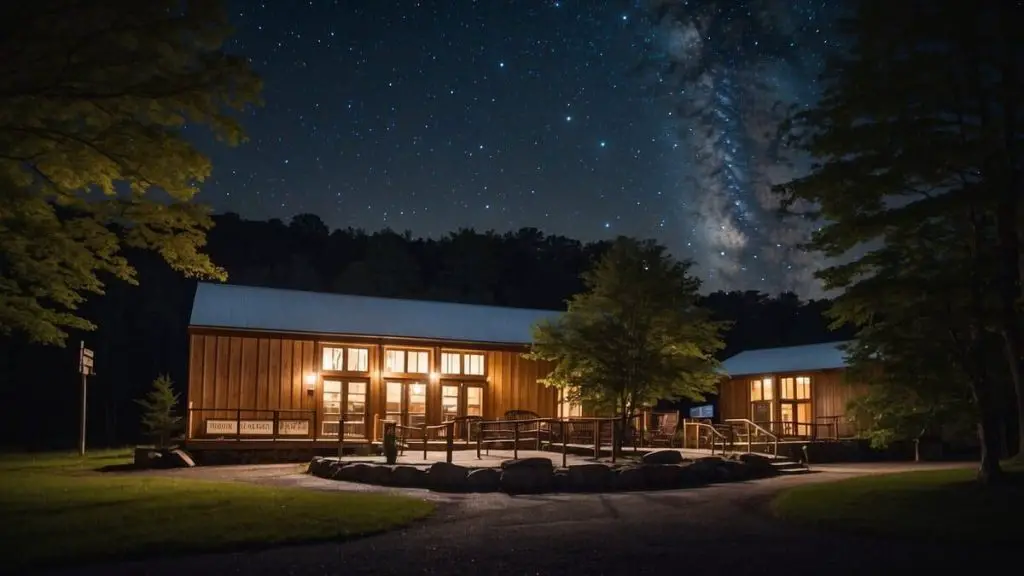
The Catskill Visitor Center in Mount Tremper, New York, serves as the gateway to the Catskill Park. Situated on a 60-acre site blending forest, fields, and wetlands, it’s an ideal spot for stargazing, thanks to its low light pollution and peaceful environment.
The center itself is equipped with various amenities:
- The Upper Esopus Fire Tower stands 80 feet tall.
- 1.5 miles of nature trails, including options for ADA accessibility.
- Picnic areas, a covered pavilion, and wildlife viewing spots.
- Access to Esopus Creek for a serene nature experience.
Encompassing over 700,000 acres, Catskill Park’s vastness and natural beauty provide excellent stargazing opportunities, particularly in more remote areas. The park’s minimal artificial light enhances the experience, making it a must-visit for astronomy enthusiasts and nature lovers.
For current information about events, including stargazing opportunities, and to plan your visit, you can check the Catskills Visitor Center’s official website and its events page.
Custer Institute and Observatory

The Custer Institute and Observatory in Southold, New York, is a haven for stargazing enthusiasts. Long Island’s oldest public observatory, established in 1927, offers a unique view of the night sky with minimal light pollution, thanks to its location in one of the darkest areas on Long Island.
Open every Saturday evening from dusk until midnight, the observatory invites you to explore the cosmos:
- View celestial wonders through powerful telescopes, including a 10″ refracting telescope, the largest of its kind in the U.S.
- Enjoy apochromatic lenses for clear views of the solar system and deep-space objects.
For astrophotography enthusiasts, members can attach cameras to the observatory’s telescopes to capture stunning sky images. The observatory’s position near Peconic Bay and Shelter Island, combined with its rich history and advanced equipment, makes it a perfect destination for amateur and seasoned astronomers.
To learn more about visiting the Custer Institute and Observatory, you can check their official website at Custer Observatory, and for additional information about the observatory and its events, visit the Night Sky Network.
Dudley Observatory
You’ll find a rich stargazing and astronomy experience at the Dudley Observatory in Loudonville, New York. Though it’s no longer a scientific observatory, it holds the title of America’s oldest non-academic astronomical research institution, with roots going back to 1852 in Albany.
Now, the Dudley Observatory is dedicated to science education and outreach. In partnership with Siena College, it offers:
- Educational programs for all ages bring astronomy closer to the community.
- Hands-on lessons that align with New York science standards inspire future STEM leaders.
One of its standout features is the Starlab, a portable planetarium offering an immersive learning experience on astronomical topics. You can also attend star parties, monthly stargazing events, and sky-watch lectures at the observatory.
This is not just a visit; it’s an opportunity to deepen your appreciation for science and explore the wonders of the night sky in an enjoyable and educational setting. Whether you’re an astronomy enthusiast or just curious, the Dudley Observatory is an exciting destination for discovering the universe.
You can visit the Dudley Observatory’s official website for more detailed information and their current programs and events.
Eighteen Mile Creek County Park

Eighteen Mile Creek County Park in Hamburg, NY, offers you a unique stargazing experience in its 466-acre natural area. The park, defined by the dramatic landscapes of Eighteen Mile Creek’s North and South branches, features a 60-foot-deep gorge that adds to its visual appeal. Its natural state and flat landscape above the gorge make it ideal for stargazing, away from significant light pollution.
During your visit, you can enjoy:
- Hiking through the forest pairs nicely with a night of stargazing.
- Fishing in the creek adds another dimension to your outdoor adventure.
In winter, the park remains accessible for snowshoeing and hiking. However, certain activities are prohibited, including camping, hunting, open fires, horseback riding, off-road bicycling, and motorized vehicles. Also, if you bring a dog, it must be curbed and leashed.
Eighteen Mile Creek County Park is not just a stargazing spot; it’s a year-round destination for various recreational activities, offering a perfect blend of adventure and tranquility under the stars.
As a natural area, Eighteen Mile Creek County Park is a serene spot for stargazing, away from city lights. You can visit the Erie County website on Eighteen Mile Creek for more detailed information about the park and its facilities.
Fire Island National Seashore
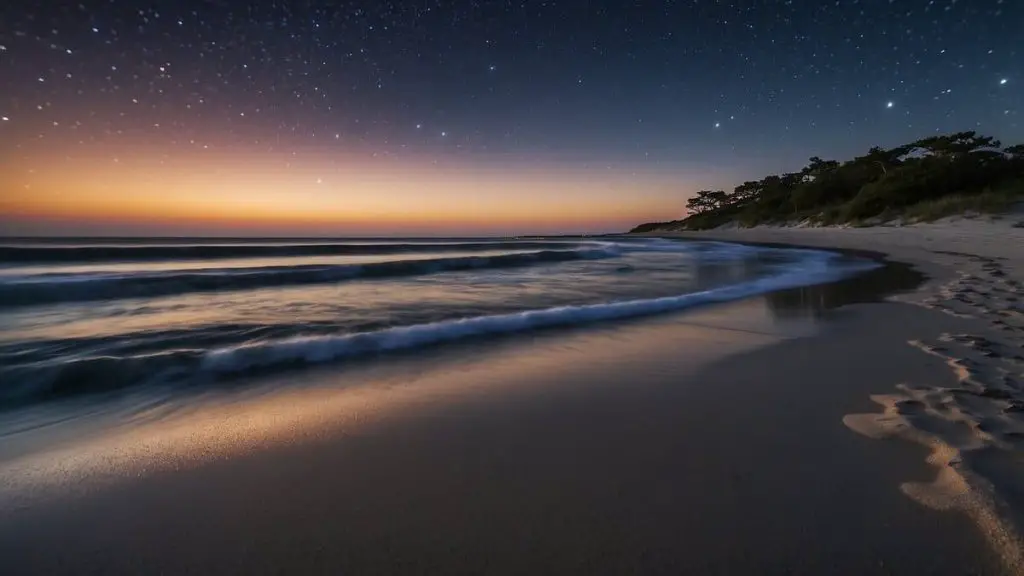
Fire Island National Seashore is a prime location for stargazing. Its dark skies create ideal conditions for viewing stars. This national seashore’s natural night-time environment enhances its beauty and offers a unique astronomical experience.
Key Programs and Opportunities:
- The National Park Service hosts stargazing programs, including Junior Ranger workshops.
- Events are held at the Wilderness Visitor Center and Fire Island Lighthouse.
For an immersive experience, consider overnight stays:
- Stay at Watch Hill and Sailors Haven marinas.
- Boats can anchor in the Great South Bay.
- Camping is available at Watch Hill Campground and in the Otis Pike High Dune Wilderness (with a permit).
Check the park’s schedule for current stargazing events and opportunities. Fire Island National Seashore combines natural beauty with educational programs, making it an ideal spot for casual observers and astronomy enthusiasts.
For more detailed information about stargazing opportunities and events at Fire Island National Seashore, you can visit the official pages of the U.S. National Park Service, Night Sky, and Explore the Night Sky on Fire Island.
Gateway National Recreation Area

Gateway National Recreation Area, stretching from Sandy Hook in New Jersey to Breezy Point in New York City, offers a unique opportunity for stargazing within the New York metropolitan area. This 27,000-acre park encompasses green spaces, beaches, historic structures, and cultural landscapes, providing a diverse environment for various recreational activities, including astronomy.
The park’s vast area and location away from the densest urban environments make it suitable for stargazing. The park’s natural setting, away from significant light pollution, is a good spot for observing the night sky.
Visit the park’s less illuminated areas during clearer nights for the best stargazing experience. Remember to plan your visit considering the park’s operating hours and accessibility to specific areas for nighttime visits.
For more detailed information and updates about stargazing opportunities at Gateway National Recreation Area, you can visit the official National Park Service page for Gateway National Recreation Area.
Gobbler’s Knob State Forest

Gobbler’s Knob State Forest in Orange County, New York, is a 303-acre area that offers an excellent destination for outdoor recreation, including stargazing.
The forest features two trout streams, the Shawangunk Ridge Trail and the Long Path. This natural setting provides a serene environment for stargazing, with at-large primitive camping allowed. When camping, ensure your site is at least 150 feet from the nearest road, trail, or body of water.
For detailed information about Gobbler’s Knob State Forest and its amenities, visit the New York State Department of Environmental Conservation.
Golden Hill State Park
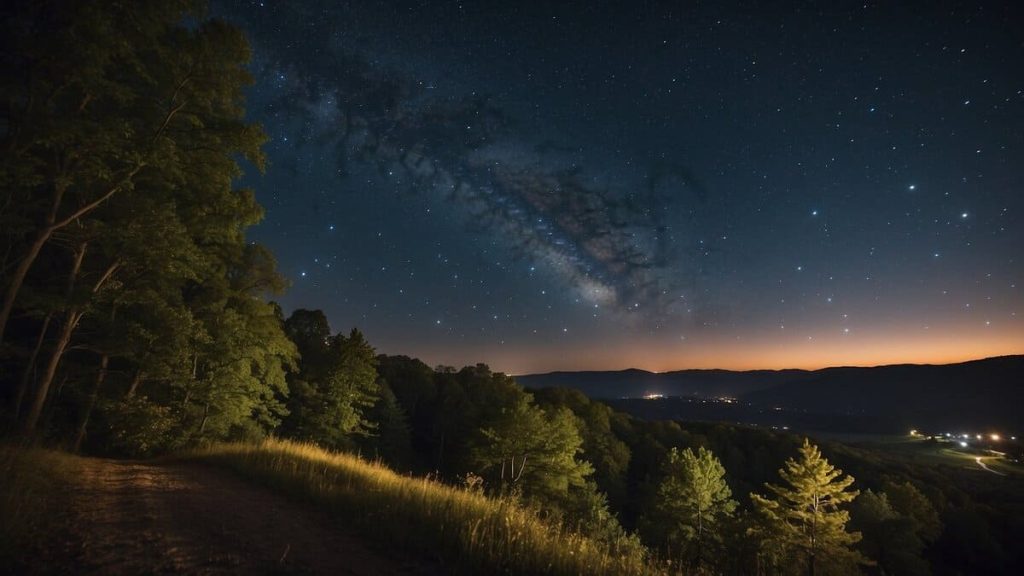
Golden Hill State Park in New York, acquired by the state in 1962, is a beautiful destination for outdoor enthusiasts. It’s known for the Thirty Mile Lighthouse, which was decommissioned in 1958 and is now available for rental.
The park offers a range of activities like camping, fishing, boating, hiking, and picnicking. The park’s location and open spaces provide good opportunities for night sky observation. The park is open year-round, offering various seasonal winter activities such as snowshoeing and snowmobiling.
For more detailed information, you can visit New York State Parks.
Hamptons Observatory
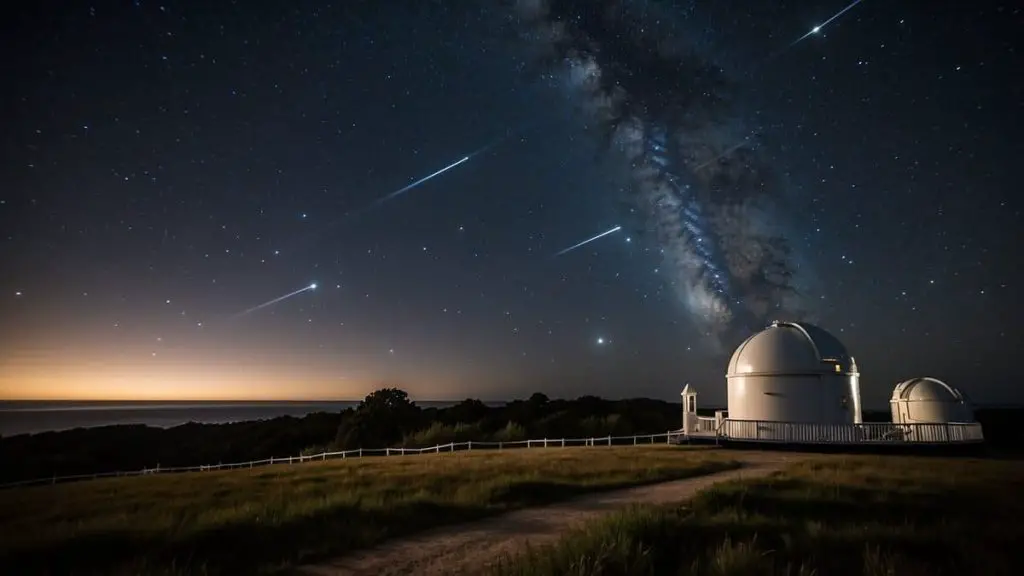
Established in 2005, the Hamptons Observatory is the first astronomical observatory on the South Fork of Long Island, New York.
It offers a range of free, family-friendly educational programs focused on science and astronomy. These include lectures, star parties, and portable planetarium shows. The observatory is a non-profit organization that fosters interest in astronomy and makes it accessible to the public.
You can visit the Hamptons Observatory website for more details about their events and programs.
Harriman State Park
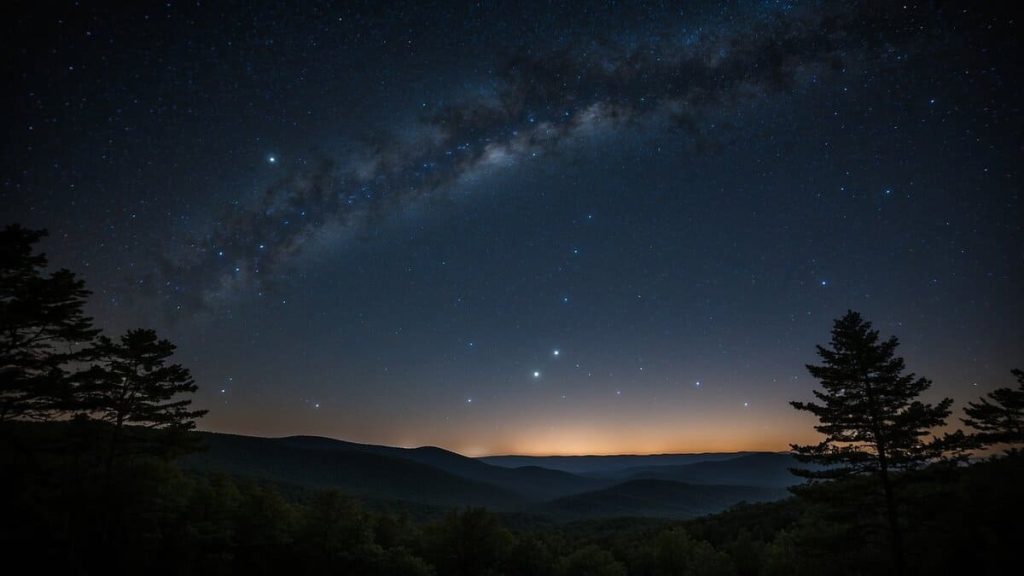
Harriman State Park, located a little over an hour north of New York City, is an excellent location for stargazing.
The park is open throughout the year and features various places for hiking, fishing, and expansive night sky views. The park also offers camping options, allowing you to extend your stargazing experience overnight. This makes it a great escape from the city’s hustle and bustle for those interested in astronomy.
Hayden Planetarium

Hayden Planetarium in New York City offers a unique and educational stargazing experience. This planetarium is not just a place to gaze at stars; it’s a virtual journey through the universe. As part of the Rose Center for Earth and Space at the American Museum of Natural History, it’s a hub for astrophysics research and science visualization.
Key Features:
- Interactive Exhibits: The Hayden Planetarium is home to various interactive exhibits that explore the cosmos, from the universe’s history to the nature of galaxies, stars, and planets.
- Advanced Technology: I was mesmerized by the ‘Worlds Beyond Earth’ space show at the planetarium, enhanced by the powerful Zeiss projector.
- Educational Programs: The planetarium offers various educational and community programs, including the Astronomy Live series. These programs provide an interactive tour of the universe and a view of the constantly changing night sky.
- Accessibility: Open daily from 10 am to 5:30 pm, the planetarium is conveniently located and accessible for visitors.
Visiting the Hayden Planetarium is more than just stargazing; it’s an opportunity to learn about astrophysics and the universe in an engaging environment.
For more information, visit the Hayden Planetarium page on the American Museum of Natural History’s website.
Hemlock Ridge Multiple Use Area
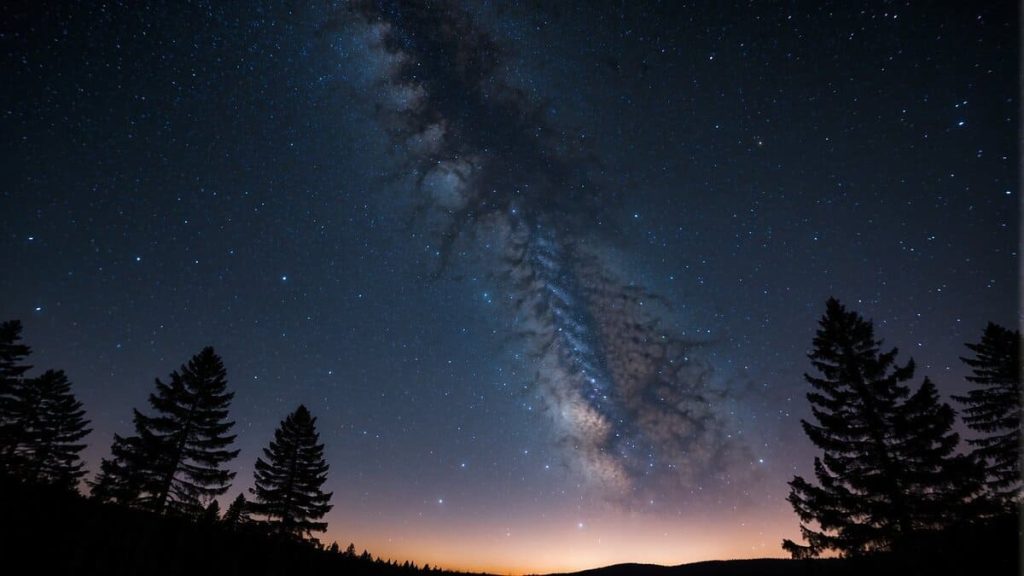
Hemlock Ridge Multiple Use Area in New York is an enchanting destination for stargazing enthusiasts. Nestled in Ulster County, this 83-acre state forest offers a serene environment ideal for observing the night sky. The forest, located on the western flank of Marlboro Mountain, is part of the Marlboro Mountains range, providing a natural backdrop for night-sky observation.
Key Features:
- Natural Setting: The area’s hilly terrain and dense forest, particularly rich in Eastern Hemlock trees, create a secluded atmosphere perfect for stargazing. The quiet and solitude enhanced my connection with the night sky, making it a peaceful experience.
- Outdoor Activities: Apart from stargazing, Hemlock Ridge offers a variety of outdoor activities like hiking, hunting, and fishing. The trails, which are unmarked former logging roads and hunting paths, traverse a terrain of sandstone and quartzite ridges interspersed with valleys.
- Wildlife and Conservation: The area is also known for its conservation efforts and the diverse wildlife it supports, including small game, turkey, deer, and bear.
- Accessibility and Camping: Hemlock Ridge is accessible via a parking lot adjacent to Lewis Road. While no designated campsites exist, at-large primitive camping is permitted, adding to the appeal for those seeking a rustic stargazing experience.
This spot particularly appeals to those who enjoy combining their love for astronomy with a taste of adventure in the great outdoors. Remember, since the trails are not marked, it’s essential to be prepared for backcountry conditions.
For more detailed information, visit the New York State Department of Environmental Conservation and the Hemlock Ridge Multiple Use Area’s Wikipedia page.
Hudson River Museum’s Planetarium

At the Hudson River Museum’s Planetarium in Yonkers, you’re in for a spectacular stargazing experience. This state-of-the-art facility, revitalized with a $1.5 million renovation in 2014, is a perfect blend of science and entertainment. It features the Ohira-Tech Megastar II projector, capable of displaying up to 20 million stars, offering a stunningly realistic night sky on a 40-foot dome.
When I visited, the planetarium’s diverse programming catered to my interests and provided a fantastic learning experience:
- Shows for Different Age Groups: From exploring the relationship between Earth, Moon, and Sun for younger children to diving into deep space science for older students and adults, there’s something for everyone. Shows like “Birth of Planet Earth” and “Legends of the Night Sky: Perseus and Andromeda” are great for ages 8 and up, providing a mix of entertainment and education.
- Interactive Experiences: Live shows like “The Sky Tonight” offer an awe-inspiring tour of the night sky, highlighting visible planets, stars, and other celestial events. This is a dynamic and engaging way to learn about astronomy.
- Special Events: The planetarium also hosts special events such as “HRM After Dark” and “Valentine’s Under the Stars,” targeting adult audiences with a combination of astronomy and social engagement.
- Educational Workshops: On weekends and school breaks, the museum organizes science workshops that delve into astronomical themes, making it a great learning opportunity for families and school groups.
Visiting the Hudson River Museum’s Planetarium is not just about observing the stars; it’s an immersive journey into the cosmos, where you can learn about astronomy in a highly engaging environment. It’s an ideal destination for both beginners and experienced stargazers.
For more information and to plan your visit, you can check out the Hudson River Museum’s Planetarium and read more about it on WAG MAGAZINE.
Kensico Dam Plaza
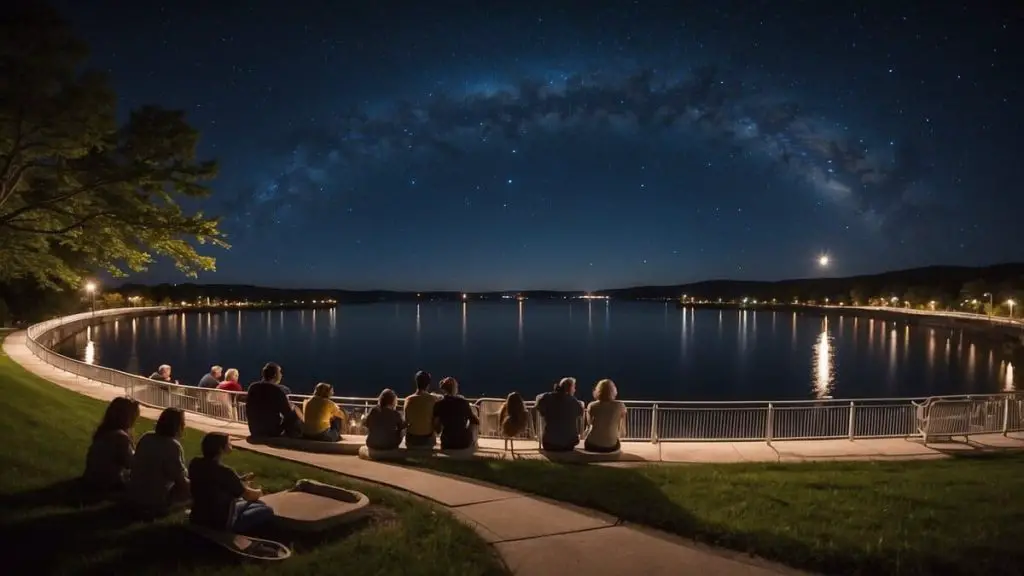
Kensico Dam Plaza in Valhalla, NY, is an attractive spot for various outdoor activities, including stargazing.
The addition of permanent park lighting in 2014 allows for after-dark activities, making it a suitable location for night sky observation. The park’s expansive open space and setting away from dense urban light pollution create an ideal environment for stargazing enthusiasts.
For more detailed information, you can visit the Westchester County Parks website.
Kopernik Observatory & Science Center

The Kopernik Observatory & Science Center, located in Vestal, New York, is renowned as a premier facility for astronomical observation and science education.
The observatory is atop a 1,740-foot hill, offering an excellent vantage point for stargazing. It’s well-equipped with powerful telescopes and hosts a variety of public programs, including Friday night stargazing sessions, educational workshops, and special astronomy events. The observatory’s location and facilities make it an ideal destination for amateur astronomers and anyone interested in learning more about the cosmos.
For more information and to plan your visit, check out the Kopernik Observatory & Science Center website.
Lafayetteville Multiple Use Area
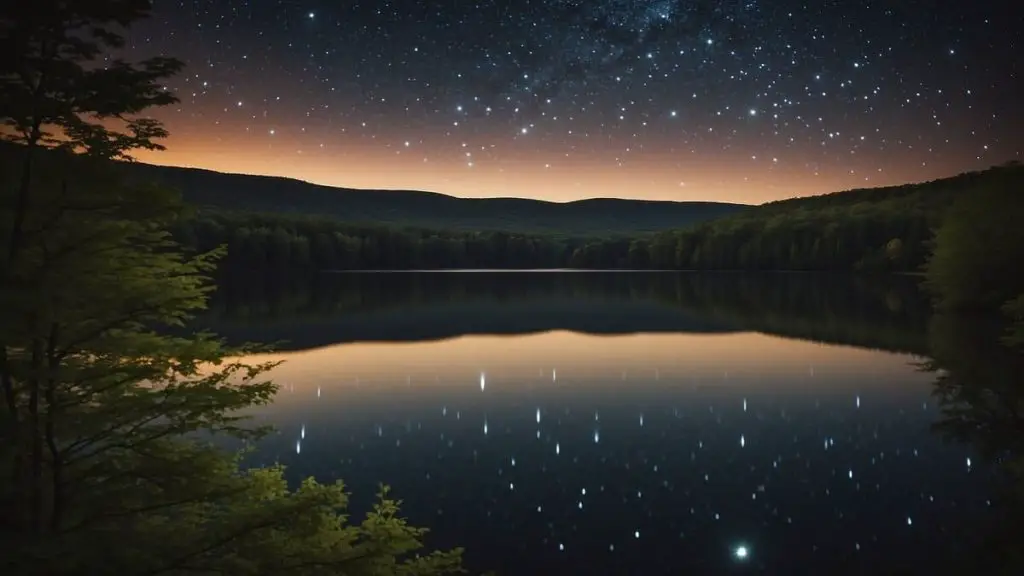
Lafayetteville Multiple Use Area in Dutchess County, New York, offers an expansive natural environment suitable for various outdoor activities, including stargazing.
This 715-acre area, open year-round, provides large undeveloped spaces ideal for nature viewing. While there are no marked trails, hiking is permitted throughout the property. The area also features Wilbur Pond, which is open for shore fishing and paddling, enhancing the outdoor experience.
For stargazing enthusiasts seeking a tranquil and natural setting, Lafayetteville offers an excellent opportunity to enjoy the night sky away from city lights.
For more information, visit the New York State Department of Environmental Conservation website.
Letchworth State Park
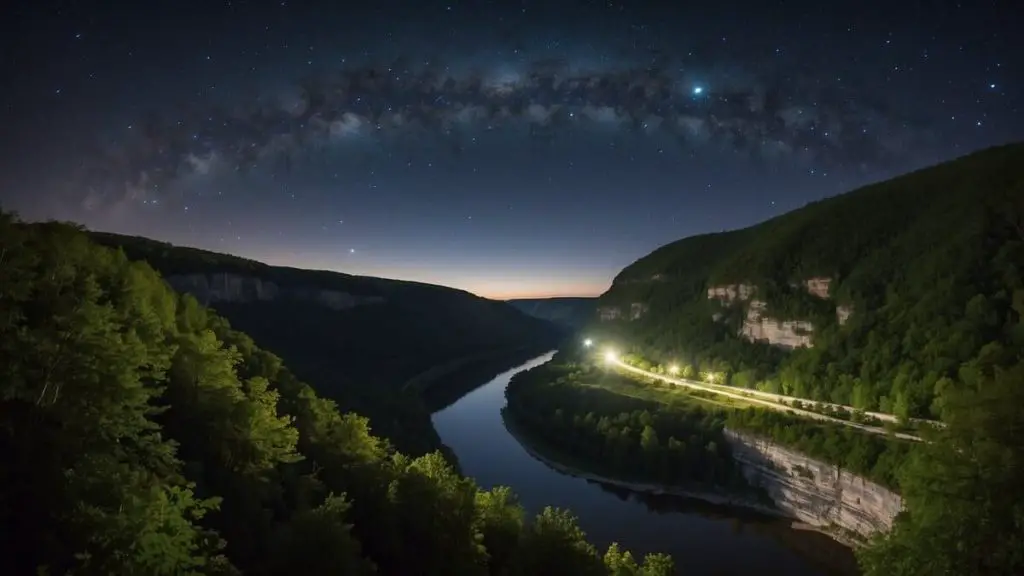
Letchworth State Park, a jewel of New York State Parks, is an excellent destination for stargazing.
Located between Niagara Falls and the Finger Lakes, the park’s south end offers prime locations for night sky exploration. The best spots include the Upper Falls/Genesee Arch Bridge, Inspiration Point, and Archery Field Overlook. With its dark skies and beautiful natural surroundings,
Letchworth State Park is a must-visit for astronomy enthusiasts.
Martz-Kohl Observatory

Martz-Kohl Observatory in Frewsburg, New York, is a non-profit organization dedicated to amateur astronomy. It’s a great place for stargazing and offers various educational programs.
The observatory hosts groups of all sizes, including scouts, school classes, civic organizations, clubs, and family groups. They participate in the Library Telescope Program, placing telescopes in local public libraries for public access.
The observatory also offers a Space STEM Camp for students and has a range of telescopes for celestial observation. The observatory is open to the public every Wednesday night, and they organize monthly lectures on astronomy-related topics.
For more information and event schedules, visit Martz-Kohl Observatory.
Montauk Point State Park
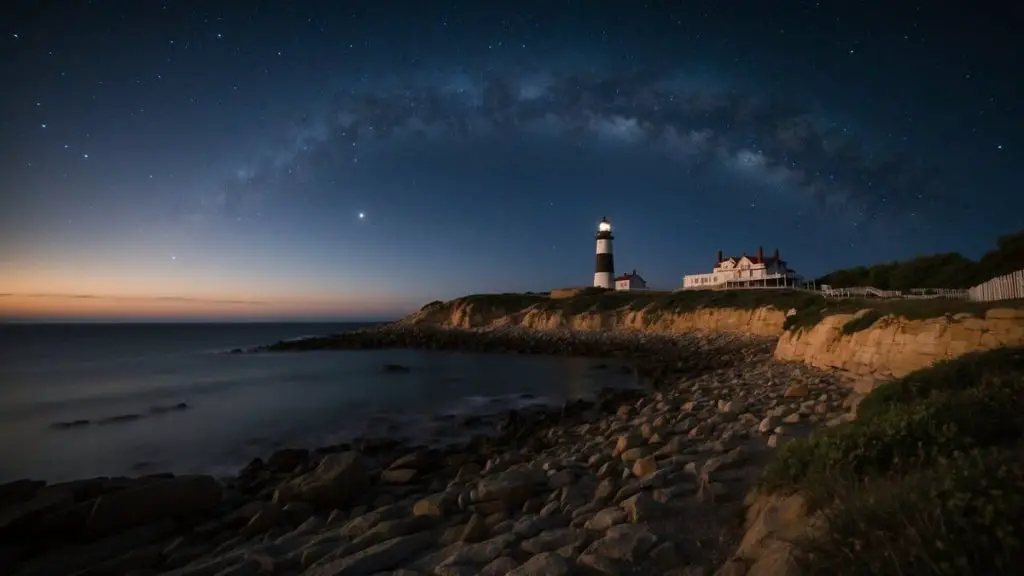
Montauk Point State Park in New York is renowned for its exceptional stargazing opportunities.
Located at the eastern tip of Long Island, the park offers a fantastic backdrop for observing the night sky, including views of the Milky Way’s core. The park’s beach setting and minimal light pollution create ideal conditions for stargazing.
You can access Montauk Point by a three-and-a-half-hour journey via the Long Island Rail Road, followed by a short rideshare to the park. I found it an excellent destination for stargazing and beach vibes during my visit.
Rochester Museum & Science Center RMSC Strasenburgh Planetarium

The RMSC Strasenburgh Planetarium in Rochester, New York, offers a journey across the universe with its spectacular shows.
You can enjoy various star shows, laser shows, and special events at the planetarium. The facility uses advanced technology to provide immersive experiences of space and the night sky. The planetarium’s show schedule is diverse, catering to different interests and age groups.
For more information on shows and tickets, you can visit the Strasenburgh Planetarium website.
The Adirondack Sky Center & Observatory
The Adirondack Sky Center & Observatory in Tupper Lake, New York, offers a fantastic stargazing experience.
It’s known for its low-light pollution, low humidity, and high altitude, creating nearly ideal conditions for night sky viewing.
The observatory features a variety of telescopes and programs designed to enhance the astronomical experience. They also participate in educational outreach, including a planned digital planetarium, and host events related to astronomy.
For more details and event schedules, visit the Adirondack Sky Center & Observatory website.
The High Line

Imagine walking along the High Line on a crisp evening in New York City. As the city lights twinkle below, you see a clear night sky, a canvas of stars above. On these special Tuesday nights, from April to October, the High Line transforms into a haven for stargazers.
The Amateur Astronomers Association enhances this experience by providing telescopes, making distant stars and celestial phenomena more accessible.
What’s remarkable about the High Line is its ability to offer a serene stargazing experience amidst the urban jungle of New York City. It’s where amateurs and enthusiasts gather, share insights, and gaze up in wonder. The juxtaposition of the bustling city life below and the tranquil, star-filled sky above creates a unique and memorable experience.
The High Line stargazing events are an extraordinary opportunity for you to connect with the cosmos while nestled in the heart of one of the world’s most vibrant cities.
For more details, you can visit Stargazing on the High Line.
Vanderbilt Museum and Planetarium

The Vanderbilt Museum and Planetarium, located in Centerport, Long Island, is a unique destination for stargazing and exploring the universe’s wonders.
This historic site, once the estate of William Vanderbilt II, now houses a planetarium that offers a range of astronomical programs and events.
Here’s what makes the Vanderbilt Museum and Planetarium unique for stargazing:
- Rooftop Observatory: The museum features a rooftop observatory open to the public every Friday night, weather permitting. You can explore the night sky through the Vanderbilt’s 16-inch Meade reflecting telescope.
- Diverse Programming: The planetarium hosts programs, including full-dome films, live star talks, laser shows, concerts, and special events. This diverse range of activities caters to both families and serious astronomy enthusiasts.
- Storytime Under the Stars: An engaging event for children, Storytime Under the Stars combines storytelling with stargazing. Kids can come in pajamas, listen to stories, and learn about constellations visible from Long Island.
- Educational Resources: The planetarium also offers educational programs and resources, making it an ideal spot for those looking to learn more about astronomy.
For more details, visit the Vanderbilt Museum’s website and New York Family’s article on The Best Planetariums in and Near NYC.
Walkway Over the Hudson
The Walkway Over the Hudson in New York offers a unique stargazing experience known as the Starwalk program.
This program transforms the Walkway Over the Hudson State Historic Park into a vibrant celestial observation and appreciation venue. It’s scheduled around significant events in the celestial calendar, making each Starwalk a unique experience.
Here are some key highlights about stargazing at the Walkway Over the Hudson:
- Starwalk Program: The Starwalk program is designed to coincide with notable celestial events, providing a rich and varied stargazing experience. It includes innovative stations where you can have fun, meet people with similar interests, and see the Walkway in a new light.
- Seasonal Event – Walkway At Night: This event is held on selected Fridays throughout the spring and summer. It allows you to walk over the Hudson, overlooking the Mid-Hudson Bridge, under a moonlit and starry sky. The event is accessible to non-members for a small fee, and it’s important to confirm your ticket entrance, either from Poughkeepsie or Highland.
- World’s Longest Elevated Pedestrian Bridge: The Walkway Over the Hudson State Historic Park boasts the longest elevated pedestrian bridge title, providing an expansive and unobstructed view of the sky above and the Hudson River below.
This experience is not just about stargazing; it’s about immersing yourself in the vastness of the night sky while suspended over the Hudson River.
The Walkway offers a serene atmosphere away from the city lights, making it an ideal spot for astronomical observations and enjoying the natural beauty of the Hudson Valley at night.
For further details, visit the Walkway Over the Hudson website and read more about the Starwalk program on Walkway Over the Hudson and New York by Rail.
Wassaic Multiple Use Area
The Wassaic Multiple Use Area in Dutchess County, New York, is a 488-acre state forest that offers various outdoor activities, including stargazing.
While it has no marked trails, the entire area is open for non-motorized recreation, such as hiking. Primitive, at-large backcountry camping is allowed, which could provide an opportunity for stargazing, especially given its relative remoteness and natural setting. Campsites must be 150 feet from the nearest road, trail, or water.
This area might be a good option if you’re looking for a less crowded and more natural environment for stargazing.
For more information, visit the New York State Department of Environmental Conservation’s Wassaic Multiple Use Area page.
Wellesley Island State Park
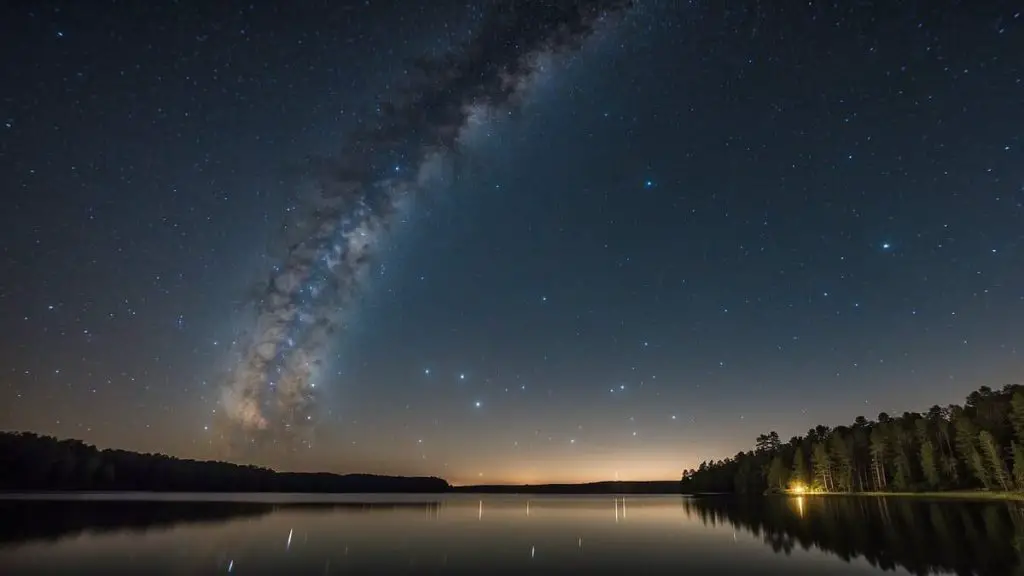
Wellesley Island State Park in New York is an excellent destination for stargazing and other outdoor activities.
One notable event at the park is the “Night Sky Adventure,” hosted by the Minna Anthony Common Nature Center. This event, typically scheduled around significant celestial events like the Harvest Full Moon, includes star and moon gazing activities. Participants learn to identify stars, constellations, and more, often accompanied by a cozy fire and smores. For such events, it’s advisable to dress appropriately for the weather and bring essential items like a flashlight and water bottle.
The park’s cabins offer a comfortable camping experience with amenities like a kitchenette, bathroom, and sleeping accommodations. Eel Bay Cottages, another accommodation option, are more secluded and often include private docks.
You can visit the Wellesley Island State Park’s Wikipedia page for more detailed information about the park and its facilities.
Astronomical Entities and Events
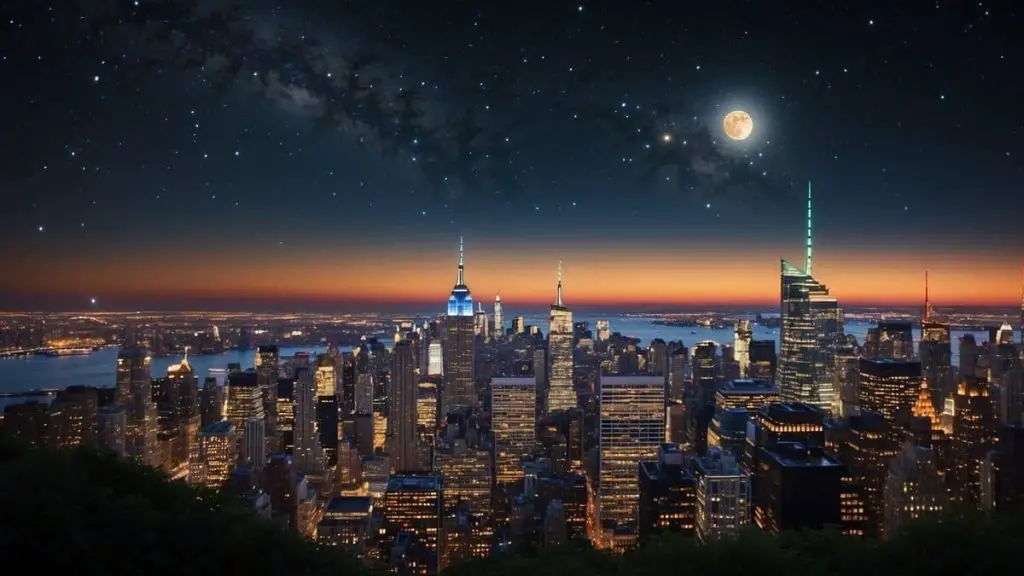
New York offers some clear nights perfect for stargazing. Here, you can spot many starry wonders, from the glowing Milky Way to the rings of Saturn.
Exploring Constellations
Constellations are like pictures in the sky. They are groups of stars making shapes. In New York, you can see constellations like the Big Dipper. On winter nights, look for Orion, which is easy to spot thanks to its bright stars.
Common Constellations to see
- Big Dipper
- Orion
- Cassiopeia
Planetary Observations: Saturn and Beyond
Planets like Saturn are fascinating to observe. Even with a small telescope, you can see its iconic rings. Sometimes, you can spot its largest moon, Titan, as a bright dot.
Tips for spotting planets
- Use a telescope or binoculars.
- Look at a stargazing app to find out when planets are visible.
Meteor Showers and the Milky Way
The Milky Way is our home galaxy. It looks like a cloudy band across the sky. Meteor showers happen when bits of space rock enter the Earth’s atmosphere and light up. They can occur at certain times throughout the year. Use an astronomy calendar to find the best dates to view them.
Outdoor Activities Related to Stargazing

New York offers impressive night-time activities for stargazers. You’ll enjoy the stars while taking part in fun outdoor adventures.
Camping and Hiking Under the Stars
Pitch your tent at Allegany State Park and reconnect with nature under a star-filled sky.
Here are steps for a memorable experience:
- Find a campsite with clear skies.
- Use a star map while you hike at night.
- Be safe; bring a buddy and a flashlight.
Boating and Fishing by Night
Float on the water and fish under the constellations. Harriman State Park is a top choice for this:
- Night boating needs lights and safety gear.
- Fishing is serene, so bring your gear and relax.
Picnicking and Swimming at Dusk
Enjoy a snack and a swim as the day turns to night. The twilight hour makes the water and sky seem magical.
Here’s what you can do:
- Pack a sunset picnic basket.
- Dip in the water as stars appear.
Community and Learning
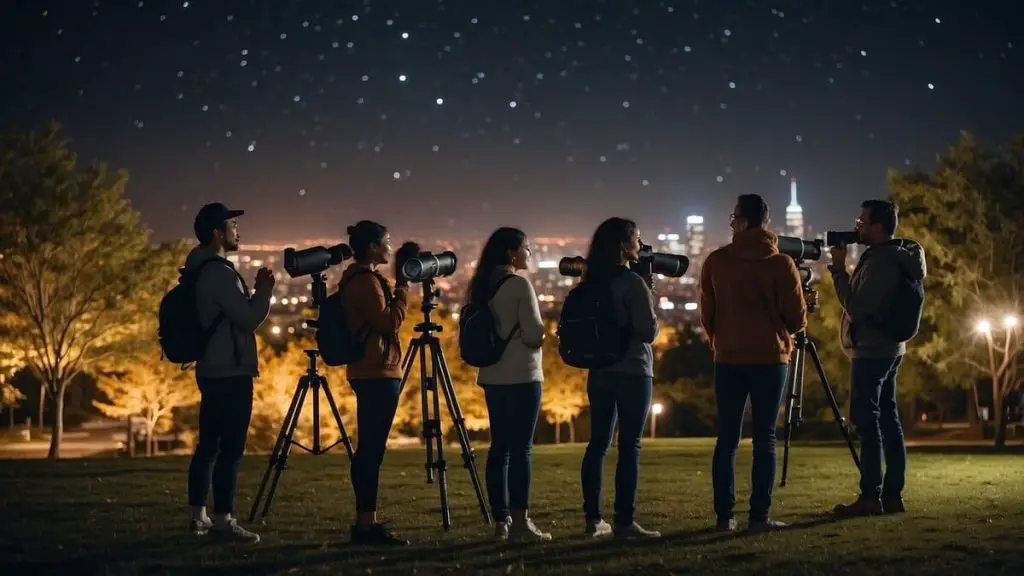
In New York, you can join communities and learn about the stars, whether you’re new to astronomy or want to deepen your knowledge. You’ll find groups and places like the Amateur Astronomers Association that make stargazing more fun and educational.
Amateur Astronomers Associations
The Amateur Astronomers Association of New York is your go-to spot to connect with fellow stargazers. They’re all about sharing their knowledge and helping you get the most out of the night sky.
Here’s what they offer:
- Free Public Stargazing Events: Meet other enthusiasts and learn to identify constellations.
- Classes and Workshops: Get hands-on experience using telescopes and more.
Observatories and Planetariums
Observatories and planetariums are fantastic places for you and your family to see the stars up close.
Some top spots include:
- Adirondack Sky Center & Observatory: Travel to this famous spot to observe the stars from one of the darkest places in the state.
- Columbia University’s Astronomy Public Outreach: Discover the universe with their telescopes every other Friday during the academic year.
Educational Programs at Universities
For those of you who crave more knowledge, New York’s universities offer astronomy programs that are both informative and exciting:
- Columbia University: Offers a variety of programs where you can dig into astronomy and learn from experts.
- Public Lectures and Events: Stay updated on lectures open to the community to help you learn more about the cosmos.
Stargazing Events and Planning
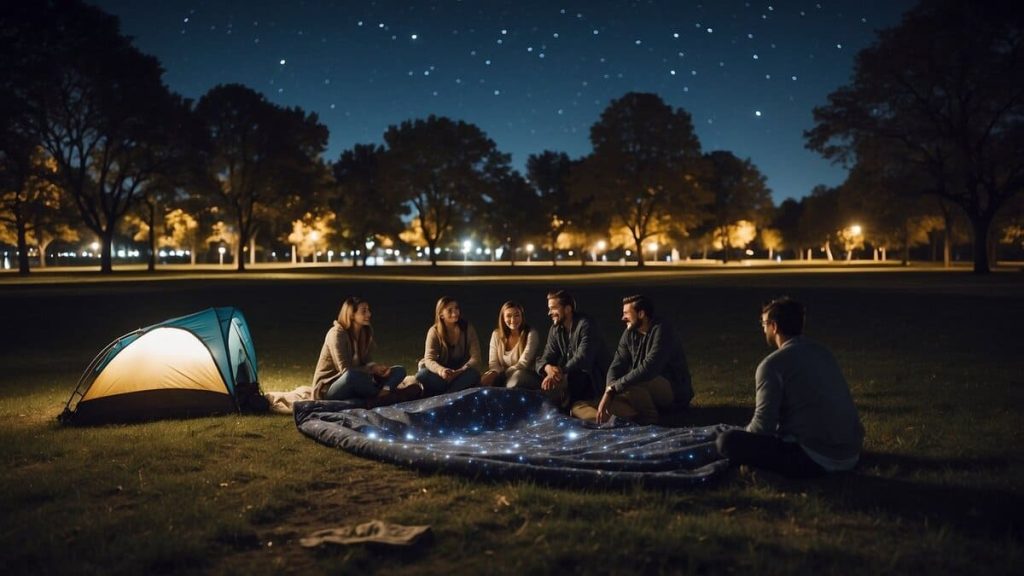
In New York, you can see the stars like never before. I’ll help you plan your adventure with event dates and preparation tips.
Annual Stargazing Schedules
- Summer Nights: Your main chance for events is during summer. Groups like the Amateur Astronomer’s Association of New York often host nights for you to gaze at the stars. Make sure to check their schedule for exact dates.
- Meteor Showers: For an extraordinary view, aim for meteor shower nights. These happen yearly, and dates can be found online quickly.
Preparing for a Stargazing Trip
To get the most out of your trip, follow these steps:
- Choose a dark spot away from city lights. Good stargazing spots can be found throughout the state.
- Check the weather forecast. Clear skies mean better star visibility.
- Pack essentials like a flashlight with red light, warm clothes, and a star map or app.
- Arrive early to let your eyes adjust to the darkness. This usually takes about 20 minutes.
Remember to respect local regulations when you visit stargazing spots. Enjoy your adventure under the stars!
Additional Outdoor Excursions
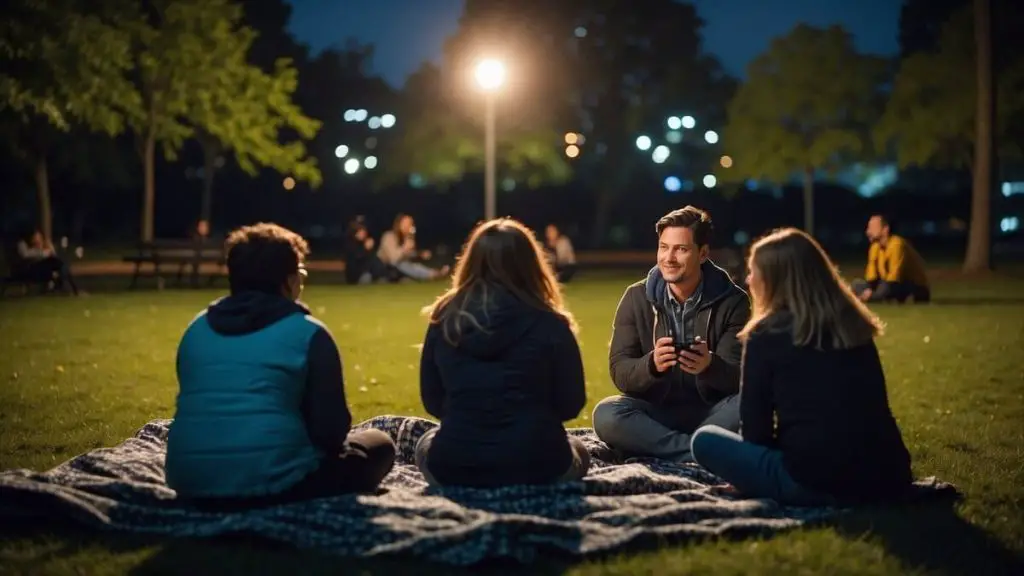
New York isn’t just about skyscrapers and neon lights. You can also dive into nature by kayaking and exploring unique landscapes.
Kayaking and Wildlife Watching
You’ll find some of the best kayaking spots outside New York City. You can paddle through quiet waterways and enjoy some wildlife watching. Here’s what you can experience:
- Peaceful Paddling: Glide across the water and soak in the tranquility.
- Animal Sightings: Keep your eyes peeled for birds and other wildlife along the shore.
Exploring the Grand Canyon of the East
Did you know New York has its own “Grand Canyon of the East”? It’s called Letchworth State Park. Here’s why it’s a must-see:
- Dramatic waterfalls and cliffs offer breathtaking views.
- Over 66 miles of hiking trails let you explore the park’s beauty at your own pace.
Conservation Efforts and Dark Sky Initiatives
New York has taken significant steps to protect the night skies and fight light pollution. These actions help you see the stars better and keep our environment healthy. Let me walk you through what’s happening in state parks and how you can join the efforts.
Protecting Night Skies in State Parks
New York State Parks are on a mission to safeguard the night sky.
This means:
- Cutting down on unnecessary outdoor lighting.
- Use lights that are less harsh and point downward.
These changes make the stars more visible and reduce harm to wildlife. You can visit dark-sky places to experience the beauty of a natural night sky.
Community Involvement in Reducing Light Pollution
You have a role in reducing light pollution, too!
Here’s what you can do:
- Replace outdoor lights with dark-sky-friendly fixtures.
- Turn off lights when you don’t need them.
- Talk to your friends and neighbors about why this is important.
By taking these steps, you help create a night sky that everyone can enjoy. Remember, every little bit helps in the fight against light pollution!
Frequently Asked Questions
Can I still enjoy stargazing in New York if I don’t have a telescope?
Yes, you can still enjoy stargazing in New York without a telescope. Many celestial sights, like constellations and the Milky Way, are visible to the naked eye, especially in areas with minimal light pollution. Binoculars are also a great, more portable option.
Are there any stargazing opportunities in New York City itself?
New York City offers unique stargazing opportunities despite its bright lights. Places like the High Line and Brooklyn Bridge Park host public stargazing events with telescopes, allowing you to view celestial objects right in the heart of the city.
How can I get involved in the stargazing community in New York?
Getting involved in the New York stargazing community is easy. Joining local astronomy clubs or groups like the Amateur Astronomers Association of New York is a great way to meet fellow enthusiasts, participate in events, and learn more about astronomy.
TL;DR
- New York offers unique stargazing opportunities, even amidst urban lights, with the best views in areas like Allegany State Park and Beaver Meadow Audubon Center.
- Winter is the optimal season for clearer skies and brighter stars in New York.
- Essential stargazing gear includes a user-friendly telescope or binoculars and a red-light flashlight to preserve night vision.
- Local astronomy groups and observatories, like the Amateur Astronomers Association, provide educational and community-focused stargazing experiences.
- The article covers practical tips for stargazing in New York, from finding dark spots to choosing the right equipment.
I’ve shared my experiences and tips, but I’m always eager to learn from yours. Do you have any stargazing stories or questions about navigating the night sky in New York?
I’d love to hear them! Share your thoughts and queries in the comments below.
Read my other articles in my Best Stargazing in US series:
- Best stargazing in Arizona
- Best stargazing in California
- Best stargazing in Colorado
- Best stargazing in Florida
- Best Hawaii Stargazing, especially on the Hawaiian Islands of Kauai, Oahu, and Maui
- Best stargazing in Maine
- Best stargazing in Nevada
- Best stargazing in New Mexico
- Best stargazing in North Carolina
- Best stargazing in Ohio
- Best stargazing in Oklahoma
- Best stargazing in Oregon
- Best stargazing in Pennsylvania
- Best stargazing in Texas
- Best stargazing in Utah




